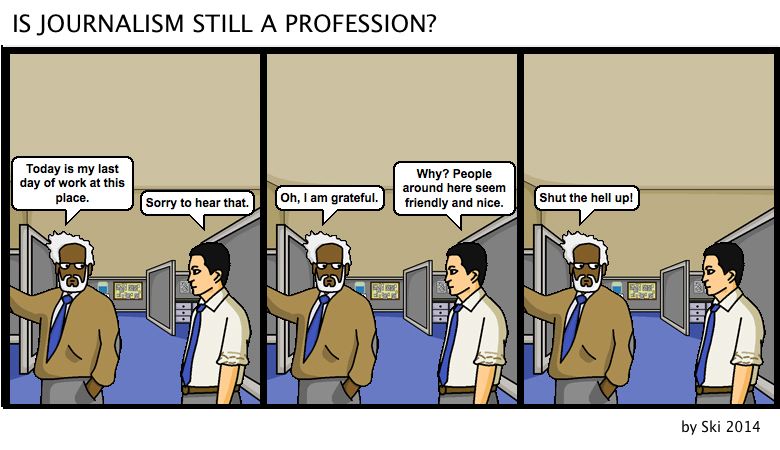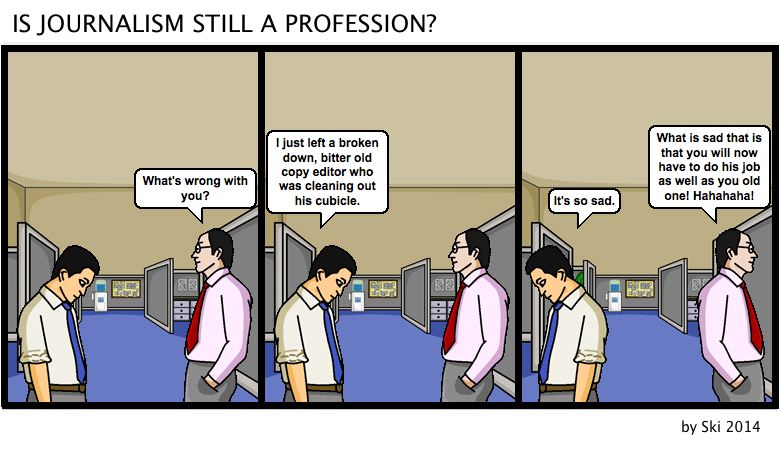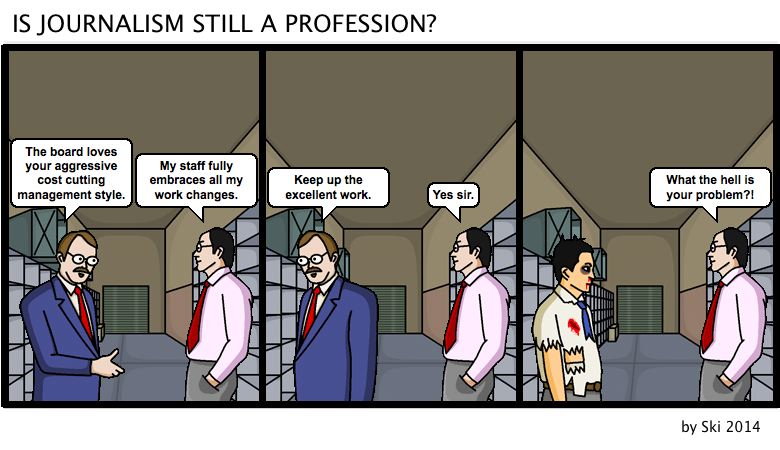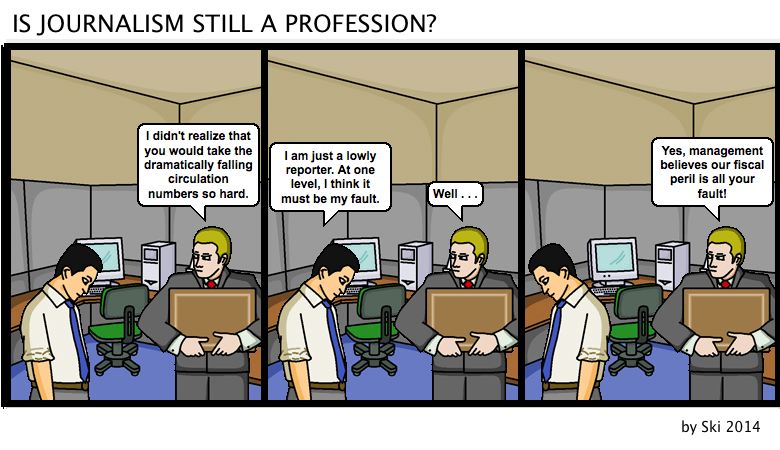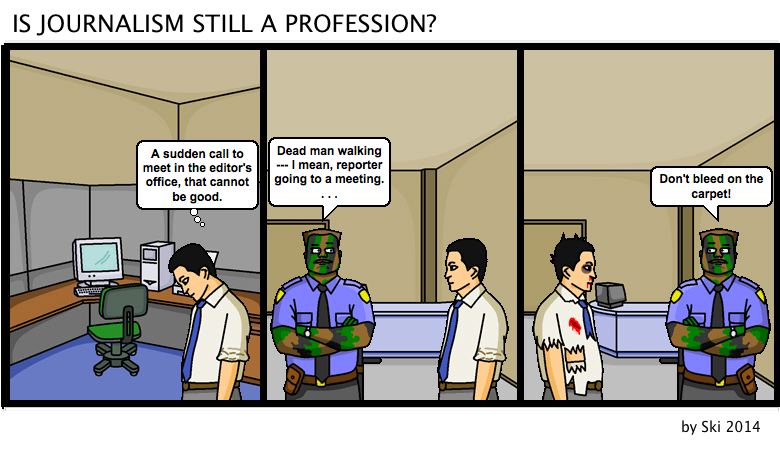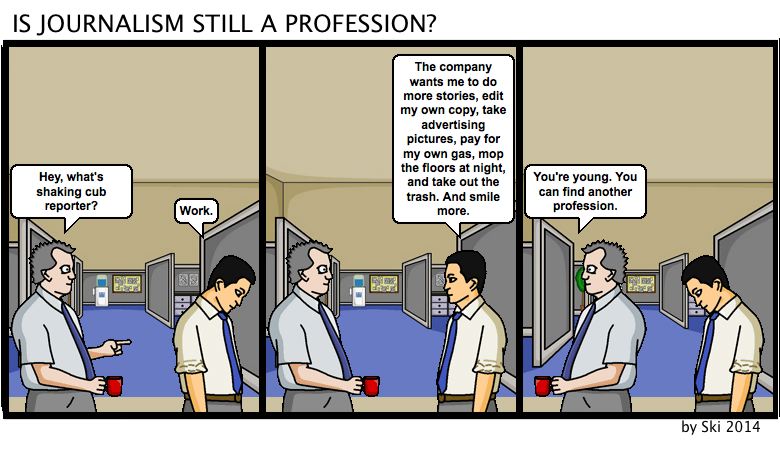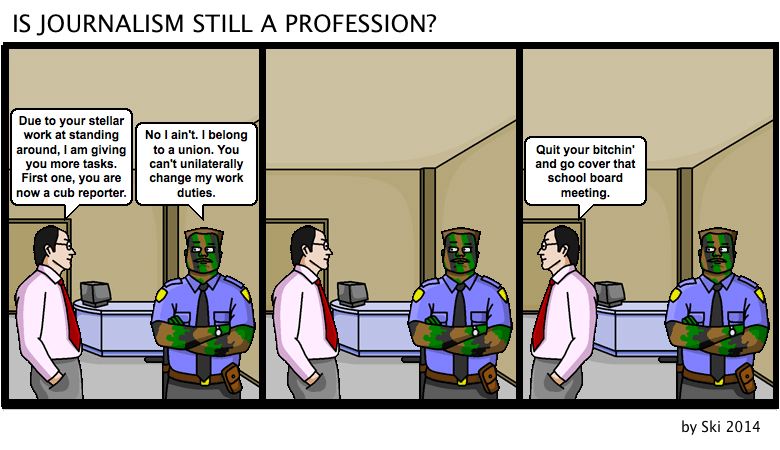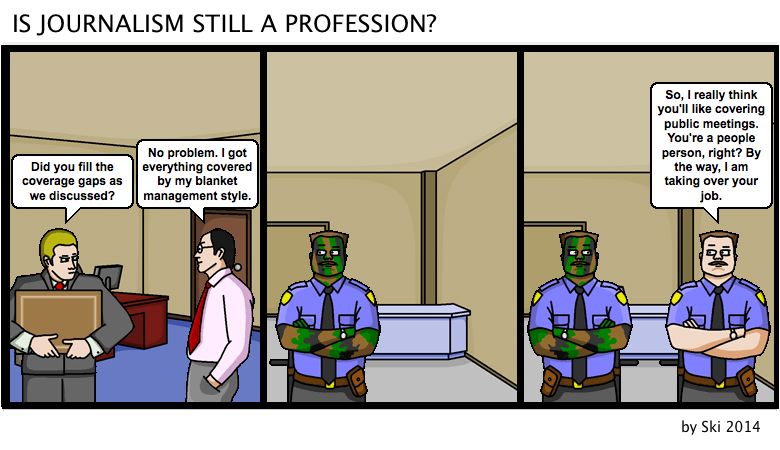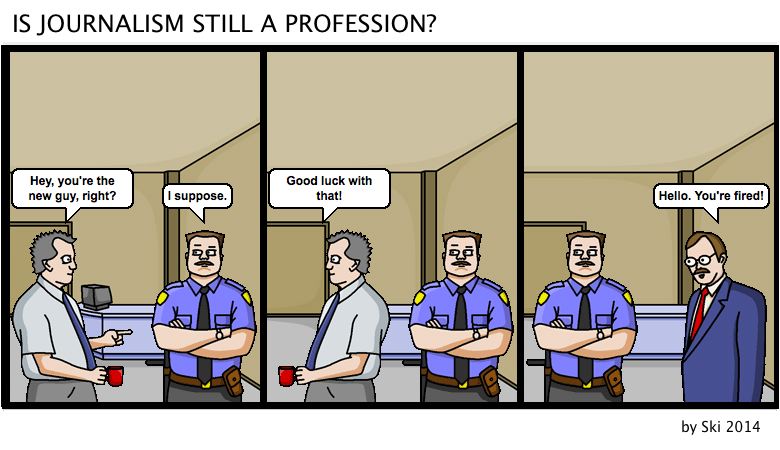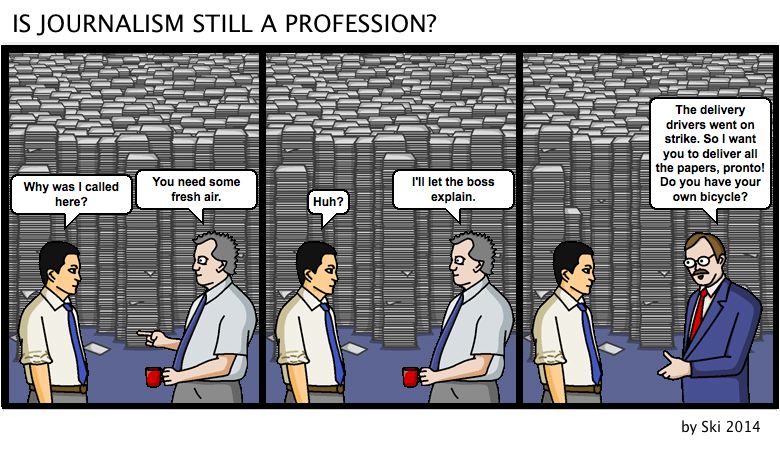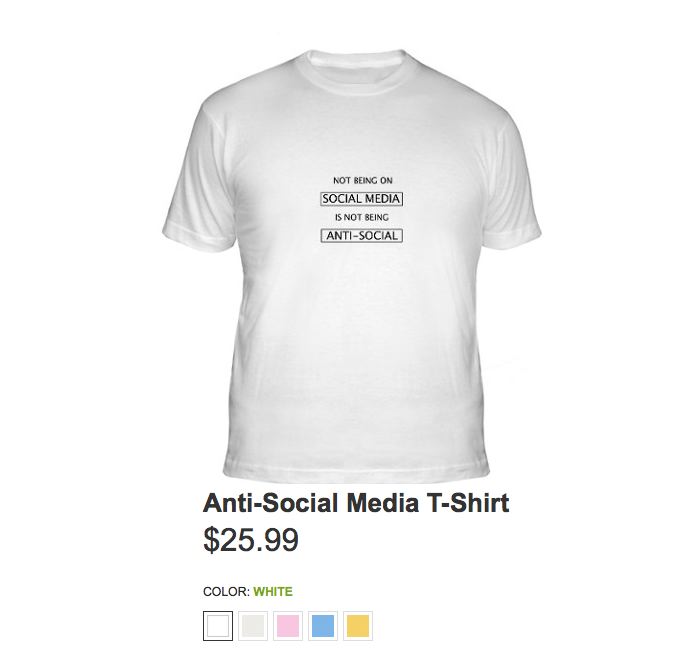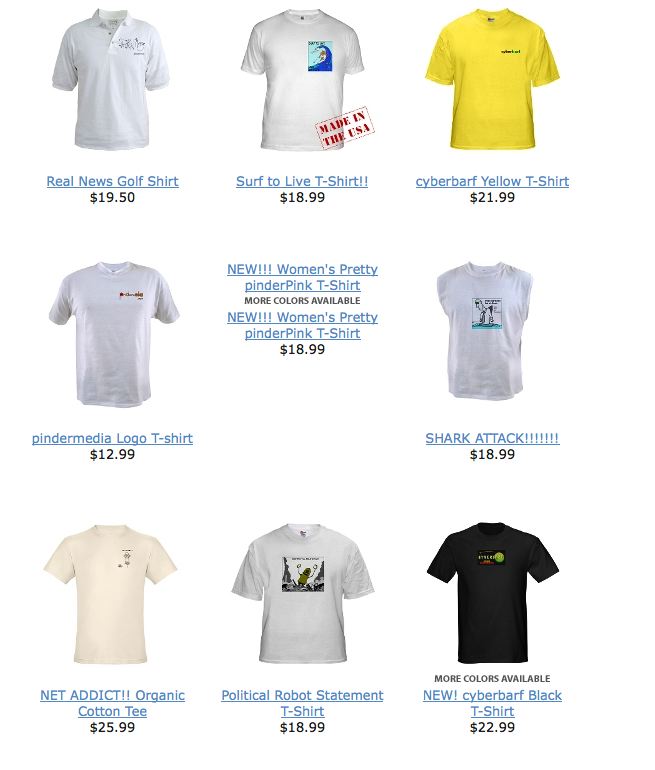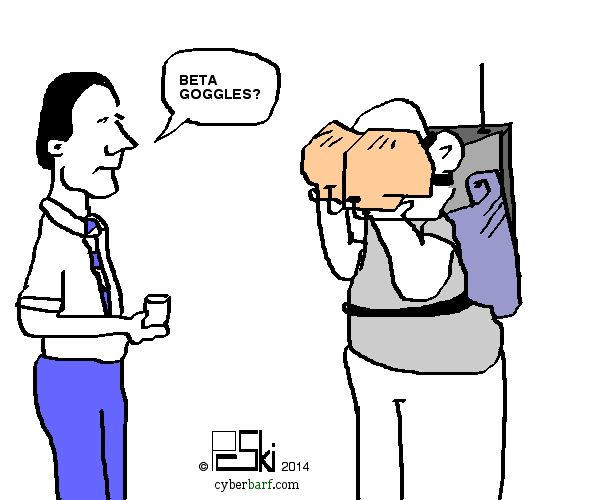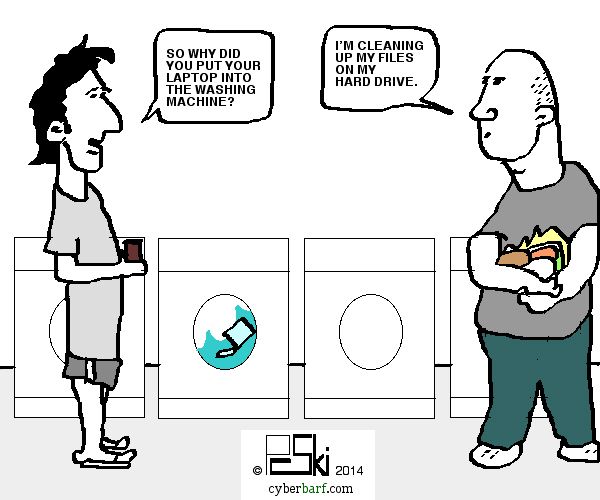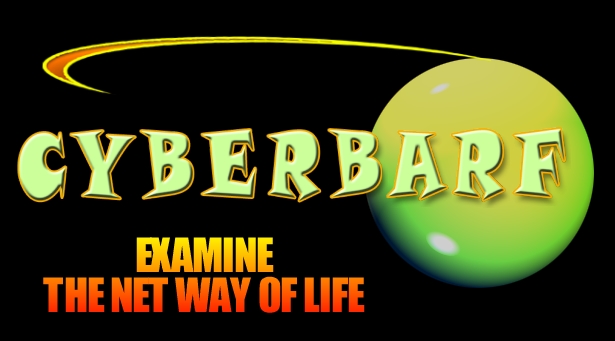|
An entire profession has the global jimjams. Journalism is the work of gathering the news by writing, editing and directing the publication of a newspaper or other periodical. News used to be defined as new information about something previously unknown; reports on recent happenings or events. But in the world where information is now an aggregator's commodity and personal opinion trumps truth, what is the current state of journalism? cyberbarf VOLUME 13 NO. 11 EXAMINE THE NET WAY OF LIFE JUNE, 2014
IS JOURNALISM DEAD? SITE UPDATE BARFETTES ANIMAL CYBERFARM iTOONS SKI'S FACE PALM WHETHER REPORT NEW REAL NEWS KOMIX! SHOW HACK!
|
|
cyberbarf EXAMINE THE NET WAY OF LIFE
QUICK & RELIABLE SERVICE
CYBERBARF T-SHIRTS, MUGS & MORE
THANK YOU FOR YOUR SUPPORT!
CYBERBARF
PRICES TO SUBJECT TO CHANGE PLEASE REVIEW E-STORE SITE FOR CURRENT SALES
|
|
cyberbarf EXAMINE THE NET WAY OF LIFE cyberbarf IS JOURNALISM DEAD? PERSPECTIVE Outside the industry, you don't hear much about the value of The Fourth Estate. An average person would not know what tha tterm means because the distribution of information has become distorted by technology. Many people think news is what pops up on their Google or Yahoo search results. News is just content on the information highway. It does not help that journalism itself has taken a seige mentality on what is happening around it. The demise of journalism is premature. It just needs to better promote its value to the average consumer. Polls indicate that people still want their local news (mostly viewed now by local TV news). However, with corporate cutbacks, the overall quantity of daily news stories has gone down. The quality of the news stories must be at a high level in order to engage and keep readership. The news business tried to adapt to wild west changes in technology, and got run over by the runaway stage coach. But so long as some people want to be informed, and so long as writers want to inform the public, journalism will continue as a noble profession. Journalism refers to the news or feature stories (light, entertainment stories) that are expressed either in a descriptive way or concise pattern through different types of media. A journalist reports news, which can be through print, television, radio, or even the Internet. The main purpose of a journalist is to report news with accurate facts in an unbiased manner. Over the decades, several types of journalism have developed that have given different dimensions to the field of mass media. One method of classification is on the basis of their specialization ( a “beat”), methods of gathering information, and a standard writing/reporting style.
The dire warning about the state of American journalism is not new. In 2008, former National Public Radio executive Ken Stern said “I have to report to you that the state of American journalism is terrible. We are in probably the most difficult and challenging time for American journalism in this country's history.” He defined journalism excluded the talking heads and commentators seen on cable television and elsewhere. “I'm talking about the industry of people, the reporters and editors who have been the heart and soul of American journalism for a couple of centuries: those who go out in the field and report and come back and try to provide the most balanced and straightforward news,” Stern said. Stern believed at the time that changes in technology and the failure of the traditional newspaper business model has led to a “free fall” in the industry. In 2000, there were about 50,000 working journalists in the United States, and most were employed by newspapers, In 2000, that number fell to 35,000. “That's a real collapse, and that comes from what has happened in the American newspaper industry,” he said. He attributed newspaper industry's atrophy to two factors. The first is that many people simply don't read newspapers anymore. About 55 percent of Americans at the beginning of the decade read a daily paper; today, that figure has fallen to 45 percent, he said. The statistics are even worse with young readers. At the beginning of the decade, about 45 percent of young people read a paper. Now, that number is down to 30 percent. The trends in ratings and circulation figures affirms those observations as there has been a steady decline in traditional media consumers. What does not help the cause is partisan reporting and sensationalism. During the Clinton Administration, partisan politics became the vehicle of choice for new web sites and bloggers as the internet was just gathering its footing as an information hub. In order to stave off the loss of readers and viewers, traditional media has gone back to the old blueprint of “yellow” journalism to hype salacious stories in order to generate business. Some of the traditional aspects of news reporting is set aside as opinion and speculation are cheaper to produce quickly in a 24/7 media environment. As explained last month, when a CNN anchor asks a panel of experts whether the missing Malaysian flight could be solved by some supernatural explanation, broadcast news jumped the speculation shark. There is only one cornerstone to the news: the truth. Only by asking pointed relevant questions to officials, can the public learn the truth. But perhaps our current society does not value the truth as it once did 20, 50 or 250 years ago. But that does not mean the press should stop looking for it.
The rise of two new forms of news gathering has played a part in the gloom of the profession. Citizen journalism is where the regular people make their contribution to a news story, whether it is an on-scene photograph of an event, or a personal story told to a news organization. In addition, local bloggers, activists or citizens may attempt to cover events in their own communities (many times as a result of a lack of coverage from the established area news organizations). . They can share facts, give suggestions, and also say what they feel about that particular event. Even after the news has been published, it is open for people to add their comments and suggestions. This method is mostly used by journalists for sensitive issues so that the citizen gets a chance to speak and another news can made with that information. People can also bring to notice issues that may have been missed by media houses. Data base journalism is an attempt to automate the news by aggregating information from internet data flows to create news stories based on the data floating around the web. This information is usually in the form of collected data, such as statics, comparative figures etc. An algorithm collects the information and attempts to organize it into a simple paragraph story. Since this type of news story does not rely on an actual person to write it, the data base created story may lack the basic elements of a journalism story (who, what, when, where and how) and context.
At the founding of the American nation, new publishers were printers. Printers who had the means of distributing the written word to the masses to inform and form public opinion on significant issues of their day. These printers were local businessmen who catered to their local customers. Throughout our own history, the press has had to adapt to technology. Although the core of journalism has always been the news, the latter word has acquired so many secondary meanings that the term “hard news” gained currency to distinguish items of definite news value from others of marginal significance. This was largely a consequence of the advent of radio and television reporting, which brought news bulletins to the public with a speed that the traditional printing press (newspapers) could not hope to match. To hold their audience, newspapers provided increasing quantities of interpretive material—articles on the background of the news, personality sketches, and columns of timely comment by writers skilled in presenting opinion in readable form. By the mid-1960s most newspapers, particularly evening and Sunday editions, were relying heavily on magazine techniques, except for their content of “hard news,” where the traditional rule of objectivity still applied. Newsmagazines had the advantage and disadvantage of time. A monthly publication allows writers and editors the time to do detailed, long news pieces (whether investigative or lengthy profile stories). But a monthly publication has to continually be ahead of the news and the interests of their readers in order to hold them from the distraction of other media. Newsmagazines began to blend reporting styles to include interpretation of the news with editorial comment. This was to give the reader additional context or insight in the issues presented in the news story. Time is the taskmaster in many professions. In the news media, to report news as present events has always been an issue. The daily newspaper was a living history of the prior day's national and local events. Many feared that newspapers, as an institution of being the record of a community, would be displaced by the invention of commercial radio. Radio broadcasters had the advantage of distributing information in real time at the actual event. Instead of waiting for the next day to read about an out-of-town game score, the radio could broadcast wire reports on the same day. Radio has always been a mixed medium: part entertainment, part news, part special programming. The news casts were usually on the hour or half hour, no more than five minutes in length. The rest of the broadcast hour was filled with talk shows, music or early on radio dramas and comedies. So, in order to stay competitive, newspapers reported the same “news” but in a longer format. The rise of the newspaper columnist who added opinion, observation and context to news stories was a way to capture a reader. The increase in feature stories was another example of broadening the appeal of the daily paper for every member of a household. Also, the use of photographs to tell a story (since radio had no pictures just listerner imagination) was a way to keep a “value” element in the print media.
But even that slight advantage changed when television came into the American home. TV broadcasters patterned their schedules after radio, in part because pioneer broadcast companies had roots in radio. Large corporations were the ones who defined the television industry because the amount of capital required to build out a new industry. It was expensive to create, manufacturer and implement the equipment necessary in order to broadcast a signal into homes. Even today, you can see many of the early traits of the first broadcasters; for example, the one camera sit-com is how early television shows were filmed because of the cost and how they were produced (more like stage plays on film.) Television had the advantage of both time and pictures to engage an audience. When TV rolled into the mainstream, it was feared that radio would be trampled and become irrelevant. But like the newspaper worries, radio did not die off. Its survival was based in large part to the focus on the local market place. Local radio stations catered to local listeners and local advertisers. As the American household became more busy (such as longer commutes and large office staffs), the personal radio became a friendly background to both at work and at play. This also was not a new concept. Newspapers, being locally owned and produced, carried great influence in their communities. Publishers did believe that they had a civic role to play to help the social and economic prosperity of their towns and cities. Reporting on crime and political corruption was a means of rooting out civic cancers that would be detrimental to the health and safety of their community. Newspapers used to weld the great power of candidate endorsements, which carried great weight especially with the generations of new immigrants who learned to read English and assimulate into society by reading their local newspapers. So long as the press continued to print the truth, it had the credibility to demand better from government officials and people in their community. Newspapers were also in the center of local boosterism of trade and commerce, such as the Chicago's World Fair of 1893. What was good for the community would be good for business, including the newspapers. It was aligned as a win-win-win situation. But things began to change when local media outlets were acquired by national companies who would build networks or chains of business enterprises. Once the new management focus of a local paper turned into the management of chain of newspapers in trying to find “economies of scale” and national advertising to increase profitability, the influence of the local publisher began to diminish. The excessive conglomeration of the news media, with cross media ownership of papers, radio and television stations, further weakened local news focus in favor of a national brand, national advertisers and later, a national “political spin” on important policy issues.
If one goes to their local library and pulls out the micro-fiche (if they still have it) to look at the old newspapers from the 1960s and 1970s, you will find a greater concentration of hard news stories than you would in today's paper or local broadcast news program. If scholars made side by side comparisons of the Vietnam War coverage to that of the Gulf War stories, the older Vietnam stories have more greater detail, analysis and impact as today's coverages. Many historians admit that when CBS news anchor Walter Cronkite voiced the view against the U.S. in the Vietnam conflict, America lost the war. Cronkite and his news division were trusted members of American society that the general public believed in. One would be hard pressed to find today an example of a newsman who could yield that much power and influence on any aspect of American life. This is a lithmus test for state of the health of the journalism profession.
As leisure time increased in the American household, radio and television adapted to provide more entertainment. One should not be surprised that news itsself become a form of entertainment. Even the iconic television show Max Headroom made that observation during the Reagan Administration. When American politics became so polarized and sleazy, opinions were more important than actual facts because opinions were easier to find and harder to rebut. High pitched arguments were more entertaining to producers than a boring investigative story on government waste. As such, both government agencies, politicians and corporations churn out their own levels of misinformation in order to look better to the general public. Public relations and incumbency sound bites rule the airwaves. Election political consultants turned their services from election year contracts into full time employment as spin doctors. This won't change because the whole cottage industry has become quite profitable. It is cheaper to throw three or four people with diverse opinions on a TV set and let them go at it then sending television crews to every corner of the planet uplinking live news events. But it is ironic that the latter was the actual vision of Ted Turner, who created CNN. He believed that if there was a breaking news story anywhere on the planet, his network would be there to cover it before anyone else. It was an expensive and money losing proposition, but ratings did spike when such events happened and the world turned to CNN to get information. But Turner and his executives retired, and CNN like other networks cut back on staffing the world. Instead, producers look to the data streams from internet sources to gather second hand information on breaking stories. It was also cheaper to produce talk shows and commentary shows than trying to fill a cable news channel with “new” news stories every hour. CNN has even reverted to feature programming with Anthony Bourdain's travel series to fill air time and boost ratings. If a news network cannot get ratings for producing actual news casts, then this is a another troublesome lithmus test for the profession.
In 2009, the Pew Research Center's Journalism Project canvassed the profession to determine the state of journalims. Published in April, 2010, Pew found that overall, most news executives are worried about journalism's future. Nearly six in ten, 58%, believe the profession is headed in the “wrong direction,” while 41% see things moving in the “right” one. But there is a noticeable split here between newspaper executives and broadcast news executives. Members of ASNE, a newspaper-related organization, are narrowly more optimistic than pessimistic about journalism’s direction; 51% see things getting better vs. 49% who see them getting worse. Broadcast news executives were strongly pessimistic. Only 35% of those who run TV or radio station newsrooms said the profession was headed in the right direction, while 64% thought it was going in the wrong direction. Another broad area of inquiry asked about fundamental values of the news business. The majority of news executives believe that the Internet is altering basic journalistic ethics, and more often in ways they find worrisome. Fully 59% said they thought “the Internet is changing the fundamental values of journalism.” Meanwhile, 40% said they thought those values are “transferring to the Internet.” Among those who see values changing, there is a broad consensus about the direction - - - and it is primarily negative. News executives saw a decline in accuracy, a lessening of fact-checking, and more unsourced reporting. The emphasis on speed of reports without fact checking was a growing concern. Executives also worried that the general public cannot differentiate between journalism reporting standards to that of non-fact check bloggers, celebrity gossip or random Tweets as being the same information as a professional journalist's news story. With the internet having too much emphasis on posting first asking questions later, at the expense of accuracy, thoroughness and fairness, is huring the journalism profession as a whole. A culture in which writers do not double check facts or seek comment from both sides in order to present a balanced story as being unprofessional. Added to the growing concern that posted “news” content has increased opinion and bias is distorting the role of traditional news media. “(The) Internet is replacing facts with conjecture,” explained one broadcast news executive in the Pew report. “Opinion (is) being disguised as fact.” However, the news executives, did not find that the growing role of citizens as significantly influencing the fundamentals of their news industry. Only 5% of the news executives mentioned citizen engagement as a source of changing news values (with newspaper executives slightly higher at 7% and broadcast executives at 4%). Nor is the loss of the press's exclusive role as gatekeeper of public knowledge at the forefront of change. Only 3% of newspaper executives and 1% of broadcasters volunteered greater access to news and information as an issue in changing standards.
The 2009 Pew report also touched upon the news media's jump into digital platforms. Thirty percent of newspaper executive respondents lamented the fact that they did not charge for their content sooner. Newspapers had derived approximately 20% of their legacy revenue from subscriptions. Broadcasters, however, never charged subscription fees for programs (free radio and TV). The news media like most other businesses were caught up in the Gold Rush propaganda to stake their digital claim on domain names and their standing in cyberspace search engine results and traffic clicks. They were told that in order to survive in a paradigm shift of technology, you had to be on the web. You had to have fresh content in order to draw and retain traffic. And the web surfers believed that the internet was a free forum of ideas and links, including any content. So news organizations ported their expensively produced content to their web sites for free access to the public. Very few people thought this through: why would people pay for a paper copy of your publication if they can just go on-line and view it for free? The only big player not to fall into that trap was the Wall St. Journal. The WSJ immediately charged a digital subscription fee for their subscribers to read their content on a computer or mobile platform. The WSJ executives knew that there product (business reporting) was the daily mainstay for brokers, bankers, politicians, business leaders, economists and world leaders - - - a valuable product that people paid a premium to access. There was no business reason to change that basic business model. The WSJ was selling its news stories no matter what the distribution method. And WSJ did not lose readership as a result of its position since their core readership already knew the value of the WSJ articles in their daily consumption of news and information.
Move forward only four years to Pew's May, 2014 report on the journalism profession. By contrast, the digital focus has become paramount and the search for new revenue streams critical. Digital sites have exploded, many funded by high worth tech billionaires. Also, the rise of philanthropic money has grown as well, in many cases focused on smaller outlets seeking to fill the gap in news coverage left by legacy cutbacks. (There is still an IRS issue with journalism being a “not for profit” enterprise for tax purposes.) There is more evidence that news is a part of the exploive growth of social media and mobile devices Pew states that half of Facebook users get news there even though they did not go there looking for it. And the Facebook users who get news at the highest rates are 18-to- 29-year-olds. The same is true for the growth area of online video. Half of those who watch some kind of online video watch news videos. Again, young people constitute the greatest portion of these viewers. Accompanying this momentum is the question of what it adds up to within the full scope of news that consumers receive. Pew reports that there are 5,000 full-time professional jobs at nearly 500 digital news outlets, most of which were created in the past half dozen years. But the vast majority of bodies producing original reporting still comes from the newspaper industry. But those newspaper jobs are far from secure. Full-time professional newsroom employment declined another 6.4% in 2012 with more losses expected for 2013. Gannett alone is estimated to have cut 400 newspaper jobs while the Tribune Co. announced 700 (not all of them in the newsroom). The Pew report only references small gains in new revenue streams like digital subscriptions and conferences. Total newspaper advertising revenue in 2013 was down 49% from 2003. Television ad revenue, while stable for now, faces an uncertain future as video becomes more accessible online. What's more, most of the new revenue streams driving the momentum are not earned from the news product itself. Local television, which remains the primary place American adults turn to for news, saw its audience increase for the first time in five years. At the same time, though, there were fewer stations producing original news compared with 2012, primarily the result of television acquisitions that left fewer companies in control of more stations. At this point, fully a quarter of the 952 U.S. television stations that air newscasts do not produce their news programs. Additional stations have sharing arrangements where much of their content is produced outside their own newsroom. The impact on the consumer seems to vary from market to market, with some markets increasing potential reach by airing news on stations that never had it – even if that newscast is the same one that airs on another local station. In other markets the news has contracted, as news organizations have reduced staff or content production for cost efficiency. In digital news, the overlap between public relations and news noted in last year's State of the News Media report became even more pronounced. One of the greatest areas of revenue experimentation now involves website content that is paid for by commercial advertisers -- but often written by journalists on staff -- and placed on a news publishers' page in a way that sometimes makes it indistinguishable from a news story. Following the lead of early adapters like The Atlantic and Mashable, “native advertising,” as it is called by the industry, caught on rapidly in 2013. The New York Times, The Washington Post and most recently The Wall Street Journal have now begun or announced plans to begin devoting staff to this kind of advertising, often as a part of a new “custom content division.” eMarketer predicts that native ads spending will reach $2.85 billion by 2014. It is the continuing chase for the advertising dollar. In other reports, in 2013 digital advertising spending has surpassed traditional television advertising for the first time. Some media publishers now align themselves with their advertisers as their “customers” rather than their readers. This causes some ethical concerns when these publishers are posting “sponsored content” as a news story when in fact it is merely a long form steath advertisement. And advertisers, knowing they have more influence now, can control or influence the surrounding news hole to create a free, positive spin for their business or industry. Advertisers have pushed their message onto the front pages of newspapers. Newspapers, whom are still viewed as “independent” by readers, lose their independent credibility if staff is now used as advertising copy writers instead of reporters. The current Pew report also has sobering news on how information is consumed in the current digital age. Pew found that digital consumers of news on sites such as Facebook have rather low levels of engagement with news sites. Bothersome is social media's self-selective process combined with algorithmic feeds are narrowing the kinds of information Americans are exposed to. A year ago, the State of the News Media report struck a somber note, citing evidence of continued declines in the mainstream media that were impacting both content and audience satisfaction. As indicated above, the Pew report states that many of these issues still exist, some have deepened and new ones have emerged. Still, the level of new activity this past year is creating a perception that something important, perhaps even game-changing, is going on. If the developments in 2013 are at this point only a drop in the bucket, it feels like a heavier drop than most. The momentum behind them is real, if the full impact on citizens and our news system remains unclear. The Pew report also notes a new area of challenge for journalism in the digital age: easy access to web-based content. The NSA spying story shows the threat to security of journalists' communications and their ability to get sources to share information with them, the ultimate impact of which could be the stories that do not get reported on and delivered to consumers. The current adminstration's war against reporters and attempts to regulate who is a “qualified” journalist in order to get a weak federal news shield protection against disclosing confidential sources was not cited in the report, but may have a devastating impact on all media. If the government can license or regulate the press, then the press has no freedom (and First Amendment advocates predict dire consequences to the fundamental principles of our constitutional democracy.)
The news media is still concerned about how to stay relevant in a digital world. The news industry in the U.S. brings in a little over $60 billion of revenue annually but advertising accounts for roughly two-thirds of this pie, most of which remains tied to legacy forms (like print subscriptions). Audience revenue accounts for about a quarter and is growing both in total dollars and in share. But this revenue may also be coming from a smaller- -or at least flat-- pool of contributors. Consultants believe that media outlets need to create new revenue streams, such as event hosting and web consulting which account for about 7% of revenue. Capital infusion from sources such as venture capital and philanthropy amount to only about 1% of total new revenue. Early on, advertisers were worried about the credibility of web traffic numbers. Since there is no physical product or independent auditor of views, many firms were burned by click algorithms and false traffic reports used to juice up advertising billings. In traditional media, ratings were done electronically and by household record books while newspaper circulation was calculated by subscriptions and news stand sales figures. That type of information can be verified. It has taken time for advertisers to trust the count meters on web pages as part of the digital ad rate formulas. It was the paid directory advertising programs of Google that business operators were skewed into paying. Salemen constantly call about increasing your search ratings or business profile for search results - - - for a monthly fee. Again, a global ranking for a mom and pop sandwich shop really does not make any business expense sense. But the internet proponents have made myths into reality on the “value” of search ranking position on the first page of results to get millions to pay for it. It is doubtful that the overall advertising pie is growing; many companies own internal web and marketing departments have taken the place of traditional media ad dollar placement services. One can see that the movement of money between traditional and digital media outlets is merely a reshuffling of the same stacks of ad dollars. The only way to pull that money back to traditional media firms is to create a new hook or element to enhance an advertiser's presence, such as the sponsored content link. Another part of the equation news executives fixate on is what kind of savings occurs at digital news startups free of the legacy infrastructure, weighed against the newer costs of technology development and maintenance. A union shop of printers and writers at a newspaper has foundational costs which continue to rise, except when the paper lays off staff or files for bankruptcy. A non-legacy brick and mortar operation such as web portal is not a union shop, but has its own infrastructre costs of tech administrators, programmers and writers/editors/designers to create its content pages. It is assumed that digital operations are cheaper to start up and run; but the open question is the sustainability of any site in the faddish culture of the internet. What were the hot and trendy web sites 10 years ago are today old, boring, passe legacy sites today. The fickle internet surfer may be drawn to newer, flashier sites which may not be better than the old ones because the current attention span of web users is decreasing in each passing year. The multi-billion dollar question is how to capture the attention of these web nomads.
Pew's survey data found that half (50%) of social network users share or repost news stories, images or videos while nearly as many (46%) discuss news issues or events on social network sites. The sharing of stories and links does not equate to hard traffic views on the originator's site. The content provider may not even get credit for the original story. This is the legacy of a early aggregators, the news portals who created page links or lifted the first paragraphs of other site's news stories to drive traffic and revenue to their portals. Digital cutting and pasting is easy, and the average person who does not create their own news content, has no emotional or ethical center about re-posting someone else's work as their own. This loose use of news content in the digital world is a concern to traditional publishers. On social sites and even many of the new digital-only sites, news is mixed in with all other kinds of content - - people bump into it when they are there doing other things. This bumping into means there may be opportunity for news to reach people who might otherwise have missed it, but less of that may be in the hands of news organizations. Only about a third of people who get news on Facebook follow a news organization or individual journalist. Instead, stories get shared from friends in their networks. And few Facebook visitors, according to a separate Pew Research study of traffic to top news sites, end up also coming to a site directly. For news providers, this means that a single digital strategy - - both in terms of capturing audience and building a viable revenue base - - will not be enough. Then there is the cultural DIY crowd. Tech savvy people with enough free time on their hands (from school, underemployment, unemployment, etc.) like to ccreate and post their own content - - - from blog posts to YouTube videos. The vast majority of these content creators are not doing it for money; they are doing it for fun. And through social linking, they can create a following very quickly. (There is a tween Vine cult which goes to “meet and greets” to see their six second media stars.) There is less of a media divide between professional content production and amateur posts. In some ways, the two are getting confused, especially when traditional media outlets try to be “hip” or “cool” and adapt the rough cut of the non-pros. Also, traditional news outlets are asking for their viewers to contribute commentary and eyewitness reports to their news operations. With the universal distribution of smart phones and digital cameras, average citizens are playing important eyewitness roles around news events such as the Boston bombing and the Ukrainian uprising. Roughly one-in-ten social network users have posted news videos they took themselves, according to the Pew data. And 11% of all online news consumers have submitted their own content (including videos, photos, articles or opinion pieces) to news websites or blogs. Citizens posting video or reports to the web is not the same as professional journalists or even citizen journalists. The latter is a person who takes the time to interview, investigate and write news stories in the traditional manner of a paid professional journalist. The citizen journalist is one who may operate their own web site which may focus on local news, sports, education or another topic of interest. A citizen journalist who operates under the same standards of balance, fairness, accuracy and truth of professionals should be accorded all the rights, privileges and access as the professional journalist. In many towns and cities, officials use a double standard against citizen journalists who may have taken the place of reporters at government meetings. Some citizen journalists were displaced or laid off former reporters. Officials may still have a little respect for a major newspaper or broadcast reporter covering an event or meeting because of its size (and legal department), but the citizen journalist rarely has any back-up support (even in their own community, as some papers consider them parasites or competition). But if one looks back to the history of the United States, the colonists who printed flyers against the Crown were all citizen journalists. And the First Amendment protects all publishers, including citizen journalists.
Besides the changes in technology and news distribution, the demographics of America is also quickly changing according to the Pew study. The Hispanic population has grown 50% from 2000 to 2012–to 53 million people. Most of that growth has come from births in the country rather than the arrival of new immigrants, reversing a trend from previous decades. As a result, a growing share of the Hispanic population is American-born and a growing number speak English proficiently. In response to these trends, more general-market media companies -- like ABC, NBC, Fox and The Huffington Post - - have started Hispanic news operations. Since 2010, six national Hispanic outlets have been launched, all of which are either owned in full or in partnership by a general-market media company. However, not all of them have been successful. Earlier this year, NBC Latino - - a website-only outlet - - closed, after only 16 months, and CNN Latino, which had both a web and on-air presence, was shut down just a year after its launch. At the same time, Fusion, a joint effort by ABC and Univision, initially described the channel as aimed at Hispanic millennials but later switched to aiming it at millennials more broadly, currently the largest and most diverse generational group in the United States. News outlets continue to hunt for key demographics in order to capture their attention (and for advertisers their disposal income). But there is question of whether these new minority demographics will fully assimulate into the American news culture. If their parents did not pick up newspapers to read English or learn about values of being a citizen (as the great immigration waves of the 1870s and 1900s did), then their children will be less likely to be news consumers. Also, these new minority cultures may be self-sufficient social pockets even in the large digital wilderness. They only have to connect with the people, places, businesses and entertainment pages of their own choosing; the term “mass media” distribution may have no effect as people can now self-filter content before it reaches their devices. Journalism is being stressed on how it can maintain its professional presence in a rapidly evolving culture that in many respects devalues any information as a commodity called content. It may wind up that professional journalism will become a craft niche in American society - - - only for those who seek out a trustworthy source of critical information about current events. But if that comes to pass, that American journalism becomes a cottage industry off the mainstream consciousness, then the nation as a whole will suffer greatly. The scales between public and private balances hinge upon a strong and viligent press. One could argue that the rise in national and local political corruption is directly related to the decline in investigative and influential national and local media outlets. Hopefully, journalism will not turn itself into a small trade publication for news junkies. For an uninformed nation, citizens will lose their freedoms and liberty by virtue of being misinformed by those in power. Libertarians have been shouting for decades about the erosion of personal freedom in America's new government Nanny state. It would be hard to imagine that our nation would go back full circle to the time of the Revolutionary War where the news of the day was published on a single printed flyer (or in this era, a single home page). The cost of rushing head first into the internet without securing payment for the news is what crippled media organizations. In order to balance the profit and loss statements, media executives continued to cut the one area that needed to be bolstered: reporting. The irony is that less people read the local papers is because they find less local news stories in them. In order to maintain traditional value in news reporting, organizations need to stress the best reporting possible - - and deliver that to their audience. In truth, their audience pays $2 for a bottle of water (which they can get for free from a tap) can afford to pay $2 for an engaging, insightful and valuable news feed from professional journalists. As it currently stands, news organizations have not sold themselves and their product as being of daily importance to their targeted audience. It will take more reporting, better stories, sharper analysis and a connection to answer why the news is important in anyone's life, in order to recapture loyal readership. And that will take money and resources in order to accomplish, which now runs contrary to current news management business models. IS JOURNALISM DEAD? The answer is clearly, no. There are thousands of dedicated individuals keeping their professional alive and relevant. The alternative question going forward is whether there will be enough dedicated individuals in the future who will value traditional journalism as much as our forefathers.
cyberbarf UPDATE CYBERSAFARI
Hi Gang! This is Cyn, your site Hostess, bringing you a state of the cyberbarf report. We still have a small but loyal readership. Thanks everyone for your continued support. As you can tell, for the past several issues, we have written more in-depth articles on various cyberculture topics. There are many crossroads converging on the interwebs - - - including the socio-legal aspects of personal communication and privacy rights. Net neutrality, data mining, government spying, content distribution and social media demands are important areas which we affect all our lives. Even though our publisher, Ski, has proclaimed “Not being on Social Media is not being Anti-Social” we are doing our best to bring him back into the dark side. Part of the push-back may be because Ski tends to go over-board when confronted with a new challenge or piece of technology. For example, he was wandering around the web and found a free comic creator called scriptcreator.com. Under a Creative Commons license, he immediately began fooling around with the clip art features and character designs. After a few days, he had suddenly created 6.5 years worth of a new weekly cartoon strip (called Gakko wu Amarini mo Sumato, whatever that means, over at skirealnews.com). It is not a compulsive disorder but more like a volcanic creative discharge from his brain attic. He still believes drawing and posting cartoons and strips like our own Show Hack! is cheaper and more rewarding than therapy. He also used stripcreator to illustrate this month's lead story on Journalism. Then there is the always contemplated site re-design idea. It seems like an annual ritual for most sites to either re-brand or alter their web home pages. There must be a marketing person saying it is a traffic boosting idea; or a tech administrator pushing for updated web creation software. It is not that Ski is philosophically adverse to change, per se, but it would take a lot of time to recommit to a ground up rebuild after a dozen years - - - with time away from work, family and friends. As he confesses below, he is not adverse to taking more risks. His long legacy investment has created a library of his works, thoughts and articles on one of the great shifts in technology and its impact on the current culture. So long as he can make the time, cyberbarf will continue to be a viable web destination. cyberbarf EXAMINE THE NET WAY OF LIFE cyberbarf barfette “There will be an increase in people who fall into the gap between the virtual and reality, leading to a pathological phenonmenon. I hardly think that this will result in people's worldviews expanding or deepening. As our information intake increases, we lose the power to concentrate on one thing.” - - - Hayao Mizazaki, 1998 barfette As the summer blockbuster movies begin to roll out on the Big Screen (like another reboot of Godzilla), it is clear that CGI has fully taken over the entertainment fields. Big budget explosion movies have the same look and feel as a big budget RPG multiplayer shooter. Also, there is passing of the value of an entertainment dollar as a $40 video game can provide a hundred hours of fun while a matinee $10 show lasts only 2.5 hours. barfette The Washington Examiner reported recently that government officials, reacting to the growing voice of conservative news outlets and the internet, are seeking to change the media's exemption from federal election laws governing political organizations. The regulation of media outlets would be a potentially chilling intervention that the chairman of the Federal Election Commission is vowing to fight. “I think that there are impulses in the government every day to second guess and look into the editorial decisions of conservative publishers,” warned Federal Election Commission Chairman Lee E. Goodman in an interview. Noting the success of sites like the Drudge Report, Goodman said that protecting conservative media, especially those on the internet, matters because it is the future of the democratization of media largely through the internet. He believes there is a clear need to keep the media free and the internet free. All media has long benefited from an exemption from FEC rules, thereby allowing outlets to pick favorites in elections and promote them without any limits or disclosure requirements like political action committees. Liberals over the years have also pushed for a change in the Federal Communications Commission's “fairness doctrine” to cut of conservative voices, and retired Supreme Court Justice John Paul Stevens has delighted Democrats recently with a proposed Constitutional amendment that some say could force the media to stop endorsing candidates or promoting issues. However, the First Amendment was created to protect citizens against government action agaisnt the exercise of their free speech, especially political speech about candidates and policy issues.
ANIMAL CYBERFARM ESSAY Some internet content providers will be more equal than others. This is a statement relative to George Orwell's dystopian novel, Animal Farm, where the concept of equality for all was supplemented by favoritism by the ruling animals. With net neutrality fading away, the large back bone providers such as telecos and cable operators, who have been losing their phone customer base, will push a “a pay to play” bandwidth market rules. Netflix has decided to be a frontrunner in this new concept. It will pay for “better” access and bandwidth to deliver streaming videos to its customers. If this takes off, then the information pipes will be divided up like apple pie slices at Thanksgiving; someone is going to be left with just crumb speeds. Free markets are a great device to spark innovation and support businesses. One side of the coin thinks that premium pay for certain content providers will make the large corporations the only players on the new web. The little guys, mom and pop retailers, to social media savvy enterpreneurs, will be left out in the cold - - - unable to pay for the access that the big boys will be paying. On the other hand, if this is a new revenue source for the bandwidth providers, it would be the incentive to build bigger and faster systems in order to make more money. But, is there a saturation level on fiber optics running through our towns?
With more and more things being housed in the cloud - - - from online gaming to large industrial information archives - - - one's ability to get a fast connection is going to be the key for everyone's digital viability. Arstechnica reported recently that Comcast Executive VP David Cohen said he doesn't think the 2010 order prohibits fast lanes or paid prioritization. “I believe that whatever it is, a fast lane, paid prioritization, whatever you want to call it, has been completely legal for 15 or 20 years,” Cohen said in a talk with investors. “Before they were [called] open Internet, they were not covered in [former FCC Chairman] Michael Powell's principles... [T]hey were not covered in the 2010 order, although the chairman said at the time that he would likely view them skeptically and was sort of a warning to everyone, be careful what you do in this space, whatever it is.” The 2010 order banned discrimination and said paid prioritization would likely not be allowed. “[B]roadband providers that sought to offer pay-for-priority services would have an incentive to limit the quality of service provided to non-prioritized traffic,” the rules state. “For a number of reasons... a commercial arrangement between a broadband provider and a third party to directly or indirectly favor some traffic over other traffic in the broadband Internet access service connection to a subscriber of the broadband provider (i.e. 'pay for priority') would raise significant cause for concern. ... [A]s a general matter, it is unlikely that pay for priority would satisfy the 'no unreasonable discrimination' standard.” There are exceptions for “reasonable network management” and “specialized services,” including the ISP's own VoIP and video offerings.May believe these exceptions could be seen as no different than paid prioritization. Cohen said the order “did not prohibit paid prioritization. So whatever it is, we are allowed to do it.” We currently have various factions interpreting the concept of net neutrality differently. The FCC will be posting for comment new internet rules which may or may not clarify the situation. Basic internet consumers and internet freedom advocates believe that the net needs to be open, free and equally accessible (by speed and bandwidth) by everyone. Businesses with large bandwidth needs such as Netflix streaming videos, depend upon a more direct distribution channel to meet the non-distruptive needs of its paying customers. And the backbone carriers have found a new revenue source to collect tolls for any business who wants their data to pushed along faster from point A to the consumer's point B.
|
|
THE PINDERMEDIA STORE IS FULL OF FUN T-SHIRTS CLOTHES, HATS AND OTHER ITEMS. CHECK OUT THE STORE FOR ITEMS
SUPPORT cyberbarf VISIT THE CYBERBARF STORE! Prices and styles may vary depending on sales, allotments, inventory. |
|
cyberbarf.com EXAMINE THE NET WAY OF LIFE iToons
cyberbarf SKI'S FACE PALM INTROSPECTION A few will call it hypocritical that a proponent against social media being the end-all for current socialization is now on a social media site. All I can say is that I had one personal reason to change. I am not against modern technology, or the internet. I use it all the time. But I still use daily my raggy paged 1966 edition of Webster's New World Dictionary. But it was time to move into social media. And change can viewed as progress. And progress is growth. And growth is good. One practical reason to hold off the plunge was that I already have a daily strangulation dance with technology. At work, I monitor a half dozen email accounts to weed the growing spam from client business. In the back of my mind was the history that if I went into another tech venture, I would overdo it. For example, skirealnews.com was only supposed to be the digital version of irregularly published The Real News, but instead it spawned three websites and fourteen years of content administration. Which is healthy to a certain point; it adds some clarity to prioritize what is important now and in the future. It takes some introspection to get your sharpened spurs deep into one's own sides in order to move yourself forward. That is why Triple Crown horses have jockeys. I still have a strong streak of protecting my privacy. But there is old saying, we're getting the band back together, which itself is a noble and rewarding goal. And if Facebook is the vehicle to ping old friends, who may get a distractive smile from their daily routines from one of my cartoons, comments or posts, then it is a satisfying by-product of my change of heart. I would not call it a cathartic nor caterwaul. I get the tribal headcount aspect of social media sites. I get the idea of staying in touch with friends on daily basis. I get the ease of simple messages and touch button comments. But at the same time I have grown out of my shell enough to still prefer one-on-one interpersonal communications. It is not a matter of self-censorship but audience recognition. I also found myself early on reigning in my cynical spirit from going hog wild on the site. This is a public site filled with hungry data miners lurking in the shadows. And some friends of friends of friends may wonder when their lives suddenly careened into the lunatic fringe. I can do diplomacy. Restraint. Stealth Edgy. So if anyone wants to metaphorically take out their pitchforks and wrap up my intestines like spaghetti swirls, fine. But I still think that those people who don't want to be on social media have a valid viewpoint on the medium. There is no wrong or right answer. It is personal decision on a platform that at times is highly impersonal with personal information. I just felt that there would be an obsessive compulsion to be “on” all the time; which is not. It is a Cliff Note headline of what friends are doing or what interests people on that day. I go into this new meme with no pressure to expand its envelope by forcing myself to remark on everything on one's newsfeed. Nor do I expect the same. I have noticed that I tone down my posts on Facebook versus private email long rants. Diplomacy. And I also find that I don't have to continually check for notifications. In this thumb click culture, I think it is healthy that I have more important things to obsess on. It may be fate to be on social webs, but one can still temper those fates. |
|
cyberbarf THE WHETHER REPORT |
cyberbarf STATUS |
| Question: Whether the fraud accusations surrounding bitcoin miners will cause digital currencies to collapse under the weight of consumer suspicion? |
* Educated Guess * Possible * Probable * Beyond a Reasonable Doubt * Doubtful * Vapor Dream |
| Question: Whether the Oracle copyright infringement appeals court decision stating APIs are copyrightable have any affect on IP patent litigation? |
* Educated Guess * Possible * Probable * Beyond a Reasonable Doubt * Doubtful * Vapor Dream |
| Question: Whether console gaming will be replaced by a new type of technology within the next ten years? |
* Educated Guess * Possible * Probable * Beyond a Reasonable Doubt * Doubtful * Vapor Dream |
|
cyberbarf EXAMINE THE NET WAY OF LIFE |
Never tell people how to do things. Tell them what to do and they will surprise you with their ingenuity. --- George S. Patton |
|
BACK IN BLACK WITH THIS CLASSIC CYBERBARF T-SHIRT!
FEATURING: THE REAL NEWS IMPACT EDITORIAL CARTOONS WRIGLEYVILLE WAR POLITICS ENDORPHIN RUSH THE DARK ABYSS RANDOM ELECTRONS SPECIALS
FEATURING: THE REAL NEWS ARCHIVES CARTOONS MADAME'S TEA HOUSE THE BAR EXPLORE THE CITY SCAPE UNDER CONSTRUCTION SURPRISES ESTORE SPECIALS |
NEW THEORIES AND ESSAYS
cyberbarf
THE STEAM PUNK SPECIAL EDITION featured new Music from Chicago Ski & the (audio) Real News: (mp3/4:14 length)
EXAMINING THE NET WAY OF LIFE cyberbarf™ distributed by pindermedia.com, inc.
|
cyberbarf
Distribution ©2001-2014 pindermedia.com, inc.
All Ski graphics, designs, cartoons and images copyrighted.
All Rights Reserved Worldwide.
